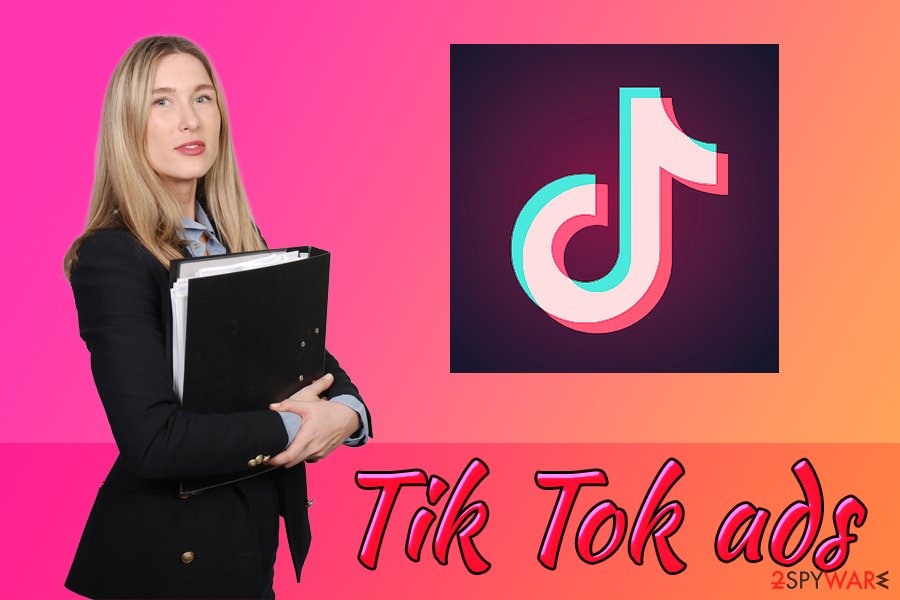Tik Tok ads (Tutorial) - Jan 2021 update
Tik Tok ads Removal Guide
What is Tik Tok ads?
Tik Tok ads is an annoying ad campaign that turned into a nightmare for YouTube, Snapchat, Twitter, and other application users

Tik Tok ads is an annoying advertisement campaign started by a ByteDance – an internet technology company from China. Initially, many people praised the app as an alternative to many social network platforms. The application TikTok was first launched in 2016 and since then got immensely popular reaching over 500 million global users. Additionally, it acquired a similar app called Muscal.y and later merged it with TikTok. It allows users to make and share short videos (usually 15 seconds long) with everyone. However, because the app reached great success in China, it started to spread elsewhere – the USA and Europe. Due to increasing popularity, app developers launched various ad campaigns (e.g., #ImaDoMe), promoting TikTok on Snapchat, YouTube, Instagram, and Facebook. The Tik Tok ad problem is especially prevalent in Asian countries like Thailand and Japan, although American users complained as well.
| Name | Tik Tok ads |
| Type | May be associated with adware |
| Associated with | Muscal.y |
| Developed by | ByteDance |
| Problem | Annoying ads on all platforms |
| Elimination | Use out instructions below |
| Optimization | Install FortectIntego to fix the damage done by adware |
According to users, these ads are everywhere: Google Chrome, Internet Explorer, Mozilla Firefox, Safari, iOS, macOS, Windows. While many users tried to disable ads by reporting it Google – it did not help. Tik Tok ads removal might be tricky, but please check the bottom section for complete instructions.
Many users complained that they are shown a girl in Tik Tok ads, while others see creepy men making weird noises. If anything, most of the users found these ads disturbing, and some even raised concerns about whether or not the app is safe to used for teens below 16.[1]

Additionally, videos like “TikTok cringe compilation” or 'MORE Cringe TikTok Ads!” are flooding YouTube as a way to make fun of low-quality ads made by random users. Finally, some users showed concerns about ads being sexist or even racist.[2]
Annoyed users on Reddit wrote:[3]
I've been getting the same Tik Tok ads.
At first I thought it was because I had watched some or Pyrocynical's videos on TikTok but now I see that everyone getting these ads.
Now nearly every time there's an ad on a video, it's a TikTok ad.
glad i'm not the only one suffering from these, the worst thing is it's not just youtube with this stupid ads, they're all over my instagram and snapchat.
These ads are a cancer on the Internet. They show up everywhere. It's another stupid trend. Call me Grandpa Kyle Broflovski, but that's how I feel.
AND THEY SHOW UP EVERYWHERE. Just like Monday.com ads on the New York City Subway.
TikTok ads might be associated with adware[4] applications. Ad-supported software is usually disguised as an allegedly useful app, such as a system optimization tool, add-on, or a toolbar. However, as soon as users install it, they notice the increased amount of pop-ups, deals, offers, coupons, and similar unwanted content plaguing their browsers.
If that is the case, you should use our instructions below, and you will be able to remove Tik Tok ads from your machine. Additionally, you should scan your computer with FortectIntego or similar PC repair software to make sure your system is running smoothly.
However, in most cases, it is not adware that is causing TikTok ads to appear. ByteDance spent a lot of money on advertising campaigns. Thus, users might be seeing it without having adware on their PCs. In such a case, the best way to avoid Tik Tok would be to install ad-blocking program, such as AdBlock or uBlock, although this solution is not optimal.

Avoid adware by installing free applications carefully
Software bundling is a widely practiced tactic when it comes to potentially unwanted program distribution. While marketers are quick to put the practice in use, there are not as many end users who are aware of this trick. Freeware authors often collaborate with each other, promoting the sponsored application by inserting it into their installation wizards. Unfortunately, they (purposely) fail to adequately disclose the full extent of the installation, sneakily asking users to opt for Recommended or Quick installation settings.
However, this is where most users make a mistake and avoid picking Advanced/Custom installation mode. For that reason, the full list of applications about to be installed remains hidden from the user, although, he or she technically agree to install them. Therefore, do not let tricky marketing practices fool you – select Advanced mode and deselect all the pre-checked boxes.
Get rid of TikTok ads
As we already mentioned, if the annoying ads are related to adware, you should use our instructions below to eliminate it. Alternatively, you can remove Tik Tok adware with the help of reputable security solutions that specialize in PUP elimination.
However, we suggest manual Tik Tok removal first. Please enter the list of apps via Control Panel (Windows) or Applications folder (Mac) and get rid of all questionable applications as explained below. We suggest you try all apps, even if they come from a well-known company. For example, some users reported that they got rid of a similar problem after they uninstalled Amazon assistant.
If that does not help, experts advise using an ad blocker. This is not an optimal solution as it might prevent you from supporting artists that you like on YouTube or other platforms but at least the annoying TikTok ads will be gone. Unfortunately, the targeted advertisements here to stay, and it is ruining many peoples' day.[5]
You may remove virus damage with a help of FortectIntego. SpyHunter 5Combo Cleaner and Malwarebytes are recommended to detect potentially unwanted programs and viruses with all their files and registry entries that are related to them.
Getting rid of Tik Tok ads. Follow these steps
Uninstall from Windows
To remove Tik Tok ads from Windows, follow these steps (please note that the method only works if the adware is hiding in your PC):
Instructions for Windows 10/8 machines:
- Enter Control Panel into Windows search box and hit Enter or click on the search result.
- Under Programs, select Uninstall a program.

- From the list, find the entry of the suspicious program.
- Right-click on the application and select Uninstall.
- If User Account Control shows up, click Yes.
- Wait till uninstallation process is complete and click OK.

If you are Windows 7/XP user, proceed with the following instructions:
- Click on Windows Start > Control Panel located on the right pane (if you are Windows XP user, click on Add/Remove Programs).
- In Control Panel, select Programs > Uninstall a program.

- Pick the unwanted application by clicking on it once.
- At the top, click Uninstall/Change.
- In the confirmation prompt, pick Yes.
- Click OK once the removal process is finished.
Delete from macOS
To get rid of the PUP on macOS, follow these instructions:
Remove items from Applications folder:
- From the menu bar, select Go > Applications.
- In the Applications folder, look for all related entries.
- Click on the app and drag it to Trash (or right-click and pick Move to Trash)

To fully remove an unwanted app, you need to access Application Support, LaunchAgents, and LaunchDaemons folders and delete relevant files:
- Select Go > Go to Folder.
- Enter /Library/Application Support and click Go or press Enter.
- In the Application Support folder, look for any dubious entries and then delete them.
- Now enter /Library/LaunchAgents and /Library/LaunchDaemons folders the same way and terminate all the related .plist files.

Remove from Microsoft Edge
Delete unwanted extensions from MS Edge:
- Select Menu (three horizontal dots at the top-right of the browser window) and pick Extensions.
- From the list, pick the extension and click on the Gear icon.
- Click on Uninstall at the bottom.

Clear cookies and other browser data:
- Click on the Menu (three horizontal dots at the top-right of the browser window) and select Privacy & security.
- Under Clear browsing data, pick Choose what to clear.
- Select everything (apart from passwords, although you might want to include Media licenses as well, if applicable) and click on Clear.

Restore new tab and homepage settings:
- Click the menu icon and choose Settings.
- Then find On startup section.
- Click Disable if you found any suspicious domain.
Reset MS Edge if the above steps did not work:
- Press on Ctrl + Shift + Esc to open Task Manager.
- Click on More details arrow at the bottom of the window.
- Select Details tab.
- Now scroll down and locate every entry with Microsoft Edge name in it. Right-click on each of them and select End Task to stop MS Edge from running.

If this solution failed to help you, you need to use an advanced Edge reset method. Note that you need to backup your data before proceeding.
- Find the following folder on your computer: C:\\Users\\%username%\\AppData\\Local\\Packages\\Microsoft.MicrosoftEdge_8wekyb3d8bbwe.
- Press Ctrl + A on your keyboard to select all folders.
- Right-click on them and pick Delete

- Now right-click on the Start button and pick Windows PowerShell (Admin).
- When the new window opens, copy and paste the following command, and then press Enter:
Get-AppXPackage -AllUsers -Name Microsoft.MicrosoftEdge | Foreach {Add-AppxPackage -DisableDevelopmentMode -Register “$($_.InstallLocation)\\AppXManifest.xml” -Verbose

Instructions for Chromium-based Edge
Delete extensions from MS Edge (Chromium):
- Open Edge and click select Settings > Extensions.
- Delete unwanted extensions by clicking Remove.

Clear cache and site data:
- Click on Menu and go to Settings.
- Select Privacy, search and services.
- Under Clear browsing data, pick Choose what to clear.
- Under Time range, pick All time.
- Select Clear now.

Reset Chromium-based MS Edge:
- Click on Menu and select Settings.
- On the left side, pick Reset settings.
- Select Restore settings to their default values.
- Confirm with Reset.

Remove from Mozilla Firefox (FF)
In case adware made changes to Mozilla Firefox, reset it the following way:
Remove dangerous extensions:
- Open Mozilla Firefox browser and click on the Menu (three horizontal lines at the top-right of the window).
- Select Add-ons.
- In here, select unwanted plugin and click Remove.

Reset the homepage:
- Click three horizontal lines at the top right corner to open the menu.
- Choose Options.
- Under Home options, enter your preferred site that will open every time you newly open the Mozilla Firefox.
Clear cookies and site data:
- Click Menu and pick Settings.
- Go to Privacy & Security section.
- Scroll down to locate Cookies and Site Data.
- Click on Clear Data…
- Select Cookies and Site Data, as well as Cached Web Content and press Clear.

Reset Mozilla Firefox
If clearing the browser as explained above did not help, reset Mozilla Firefox:
- Open Mozilla Firefox browser and click the Menu.
- Go to Help and then choose Troubleshooting Information.

- Under Give Firefox a tune up section, click on Refresh Firefox…
- Once the pop-up shows up, confirm the action by pressing on Refresh Firefox.

Remove from Google Chrome
Delete malicious extensions from Google Chrome:
- Open Google Chrome, click on the Menu (three vertical dots at the top-right corner) and select More tools > Extensions.
- In the newly opened window, you will see all the installed extensions. Uninstall all the suspicious plugins that might be related to the unwanted program by clicking Remove.

Clear cache and web data from Chrome:
- Click on Menu and pick Settings.
- Under Privacy and security, select Clear browsing data.
- Select Browsing history, Cookies and other site data, as well as Cached images and files.
- Click Clear data.

Change your homepage:
- Click menu and choose Settings.
- Look for a suspicious site in the On startup section.
- Click on Open a specific or set of pages and click on three dots to find the Remove option.
Reset Google Chrome:
If the previous methods did not help you, reset Google Chrome to eliminate all the unwanted components:
- Click on Menu and select Settings.
- In the Settings, scroll down and click Advanced.
- Scroll down and locate Reset and clean up section.
- Now click Restore settings to their original defaults.
- Confirm with Reset settings.

Delete from Safari
Remove unwanted extensions from Safari:
- Click Safari > Preferences…
- In the new window, pick Extensions.
- Select the unwanted extension and select Uninstall.

Clear cookies and other website data from Safari:
- Click Safari > Clear History…
- From the drop-down menu under Clear, pick all history.
- Confirm with Clear History.

Reset Safari if the above-mentioned steps did not help you:
- Click Safari > Preferences…
- Go to Advanced tab.
- Tick the Show Develop menu in menu bar.
- From the menu bar, click Develop, and then select Empty Caches.

After uninstalling this potentially unwanted program (PUP) and fixing each of your web browsers, we recommend you to scan your PC system with a reputable anti-spyware. This will help you to get rid of Tik Tok registry traces and will also identify related parasites or possible malware infections on your computer. For that you can use our top-rated malware remover: FortectIntego, SpyHunter 5Combo Cleaner or Malwarebytes.
How to prevent from getting adware
Access your website securely from any location
When you work on the domain, site, blog, or different project that requires constant management, content creation, or coding, you may need to connect to the server and content management service more often. The best solution for creating a tighter network could be a dedicated/fixed IP address.
If you make your IP address static and set to your device, you can connect to the CMS from any location and do not create any additional issues for the server or network manager that needs to monitor connections and activities. VPN software providers like Private Internet Access can help you with such settings and offer the option to control the online reputation and manage projects easily from any part of the world.
Recover files after data-affecting malware attacks
While much of the data can be accidentally deleted due to various reasons, malware is one of the main culprits that can cause loss of pictures, documents, videos, and other important files. More serious malware infections lead to significant data loss when your documents, system files, and images get encrypted. In particular, ransomware is is a type of malware that focuses on such functions, so your files become useless without an ability to access them.
Even though there is little to no possibility to recover after file-locking threats, some applications have features for data recovery in the system. In some cases, Data Recovery Pro can also help to recover at least some portion of your data after data-locking virus infection or general cyber infection.
- ^ Diane Lee. Tik Tok app raises concerns for young users. WSPA.com. CBS-affiliated television station.
- ^ Abby Ohlheiser. Inside TikTok, the premier app for firefighters who enjoy lip-syncing to ‘Baby Shark’. Washington Post. Breaking News, World, US, DC News & Analysis.
- ^ Holy s**t can these TikTok ads f**k off from existence. Reddit. Social media platform.
- ^ Adware. Wikipedia. The Free encyclopedia.
- ^ Dr. Nathalie Maréchal. Targeted Advertising Is Ruining the Internet and Breaking the World. Motherboard.
